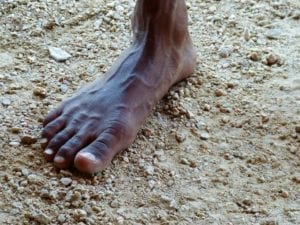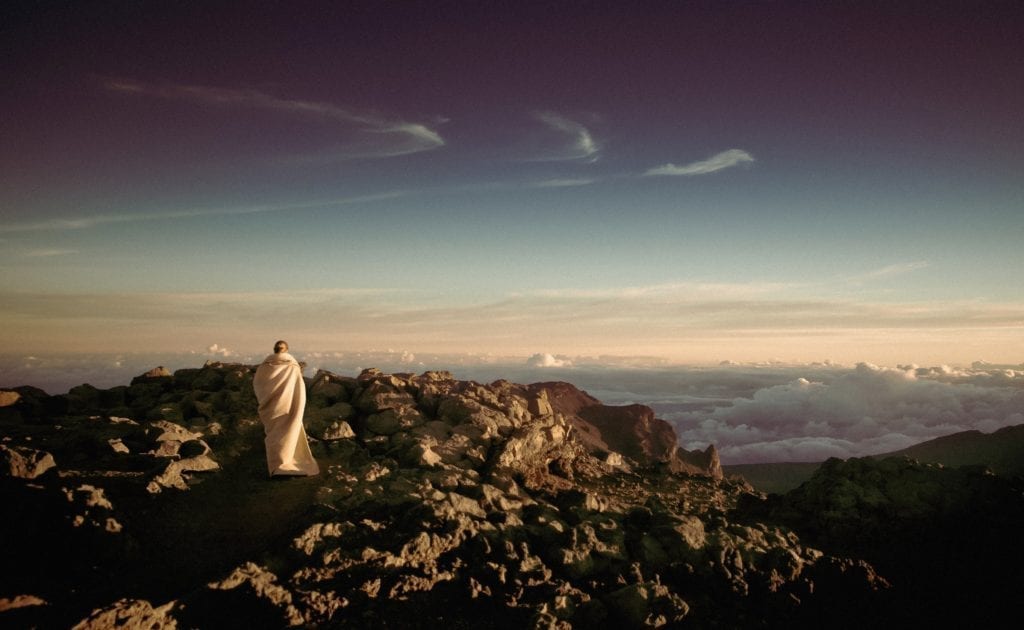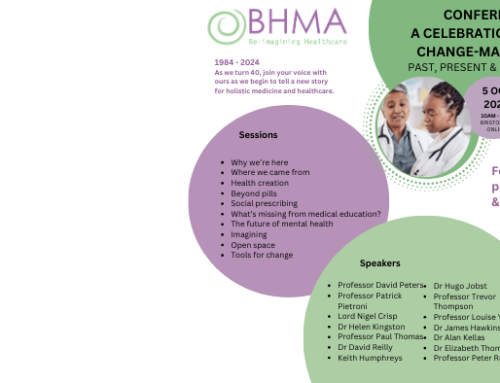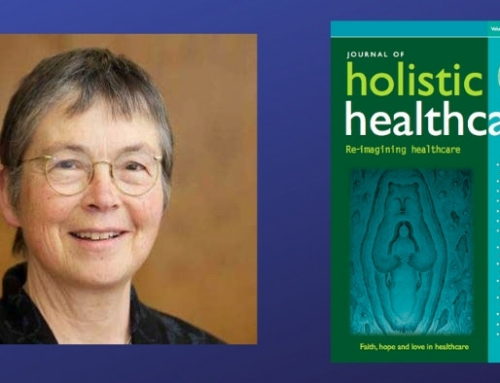To recover from ecological disaster, we humans must transform the sense of who we are in relation to the Earth. In Search of Grace is Peter Reason’s story of his ecological pilgrimage in his small yacht Coral, from Plymouth round the west coast of Ireland, to the far north of Scotland. His book explores the central themes of pilgrimage: separation from the everyday, venturing forth, and returning home. It tells of meeting wildlife, visiting sacred places, confronting danger, expanding and deepening the experience of time, of silence and of fragility.
For two days and two nights, Coral lay at a visitors’ buoy at Craighouse on Jura in the Western Isles of Scotland while the northwesterly gale blew. Fierce squalls came gusting down through the mountains, bringing heavy rain rattling on the deck and sprayhood. This was the final stage of my ecological pilgrimage round the west coast of Ireland to Scotland, sailing mostly on my own. For the past month I had been sailing from Clifden on the west coast of Ireland, mostly on my own. The weather had been particularly difficult. I was weary, and keen to get to Coral’s winter berth near Oban.
Eventually the gale blew through. Overnight the wind dropped away to nothing. In the grey dimness just before dawn I dropped the lines on the mooring buoy and steered Coral out of the bay. The green and red navigation lights that mark the channel between Goat Island and the under- water reefs flashed reassuringly. Once clear of the island I turned Coral north up the Sound of Jura, intent on catching the last quarter or so of the flooding tide north toward Oban. I had it all worked out: the tide times, the landmarks, the alternative anchorages along the coast.
When the tide turned against me, I took Coral into Lussa Bay, tiny, south- facing, 12 miles or so north from Craighouse, and tucked her in behind a rocky peninsula out of the stream.
A lone cormorant stood sentinel on the tip of the rocks. Low cloud enveloped the hilltops and mist descended to sea level, full of damp- ness that now and again turned into light rain. The ensign hung soggily from the backstay. Through the mist the tones of the land were subdued: a sharp green scrub, russet brown bracken, punctuated by the black silhouettes of windblown trees; rocks dark and wet at the waterline, lighter above. In contrast to this wildness, at the head of the bay I could just see a little pocket of cultivation: a house showing white amid a cluster of mature trees; a bridge over a stream; a meadow where a brown horse was grazing.
Once I was sure the anchor was secure, I cut the engine. Its mechanical grumble and the churn of the propeller had filled my ears for two hours. Once it stopped, I felt the silence as a tangible presence inviting me to open to my surroundings. Gradually my ears cleared of engine noise and I could hear the subtle watery sounds around me: the back- ground burbling of the tidal stream out in the sound; the deeper, hollow percussion of wavelets slopping against the rocks; the occasional creaks from the engine as it cooled down; above all these the faint patter of fine rain on the deck and sprayhood that came and went as showers blew through the bay, punctuated by the thud of larger drops falling from the boom.
As I stood in the companionway out of the rain, looking across the bay, I heard a guttural call. I looked around and saw a raven flapping its wings to land among the rocks, the inky black of its feathers penetrating the rain mist and standing out strongly against the grey of the rocky shore. I watched as it searched the foreshore. Then another movement caught my eye, across the water this time: an otter, maybe, but more likely a seal. I searched the surface hopefully, but saw no further sign.
I came into this bay for the purely practical purpose of waiting out the adverse tide. But I was enchanted. I spent hours watching, listening, scribbling incoherent notes as I searched for the right words. The quiet of this bay silenced my mind. I was absorbed with just being there.
By mid-afternoon the ebb had weakened. It was time get going again to reach the tidal race at the Sound of Luing at slack tide. I started the engine, hauled up and stowed the anchor, edged Coral round the low rocky headland that had sheltered us and continued northwards.
 There is a longstanding tradition in most human societies of making a more or less arduous journey away from the comforts and familiarities of home in search of new insights and deeper understandings. This practice may be as old as the human species: mesolithic peoples in Europe certainly made long journeys to the sacred sites marked by stone circles; the Aboriginal people of Australia still take extended walks along ‘songlines’, re-enacting the journeys of ‘creator-beings’ during the Dream Time.
There is a longstanding tradition in most human societies of making a more or less arduous journey away from the comforts and familiarities of home in search of new insights and deeper understandings. This practice may be as old as the human species: mesolithic peoples in Europe certainly made long journeys to the sacred sites marked by stone circles; the Aboriginal people of Australia still take extended walks along ‘songlines’, re-enacting the journeys of ‘creator-beings’ during the Dream Time.
The idea and practice of pilgrimage was systematically forged in a religious context. There is the requirement of good Muslims to undertake the Hajj at least once in their lives; of the Christian pilgrimages of the Middle Ages and the continuing contemporary practice; the vast numbers of Hindu devotees who travel to sacred sites on the River Ganges; and of Buddhists who walk the difficult path to circumambulate Mount Kailash. In modern times the word has perhaps become devalued, it has become customary to speak of pilgrimage in a secular sense: a Wagner devotee may describe a trip to the Bayreuth Festspielhaus as a pilgrimage, as might a cricket lover a visit to Lords (see Clift and Clift,1996; Coleman et al, 1995; Westwood, 1997; University of York, 2014).
The English term ‘pilgrim’ originally comes from the Latin word peregrinus (per, through plus ager, field, country, land), which means a foreigner, a stranger, someone on a journey, or a temporary resident. It can describe a traveller making a brief journey to a particular place or someone settling for a short or long period in a foreign land. Peregrinatio was the state of being or living abroad; and of course all Christians were seen as temporary residents in this world, ‘strangers and pilgrims in the Earth’, travelling toward ‘a heavenly country’. Here on earth, wrote St Augustine, Christians wander ‘as on pilgrimage through time looking for the Kingdom of eternity’ (Bunyan, 1678; St Augustine, 1958; Leopold, 1949). This contrasts with an ecological view that we are indigenous Earthlings first: we are not just passing through; we evolved with and profoundly belong to this planet. Our place is not in heaven, but here. As Aldo Leopold, one of the originators of the modern ecological movement, put it, we are plain members of the biotic community (Leopold, 1949).
In modern times, the idea of pilgrimage falls within so many cultural and spiritual traditions that it holds no single meaning. However, it usually entails a long journey in search of qualities of moral or spiritual significance, a journey across both outer physical and inner spiritual landscapes. A pilgrim separates herself from home and familiars, may join with a group of like-minded seekers, sometimes wearing special clothes or other marks that indicate their pilgrim status. In an important sense the pilgrim leaves the everyday and familiar, and journeys through an in-between space toward some transcendent purpose. The Hindu concept of the tirtha, a Sanskrit term for a ford or intersection between two realms, expresses this well. Places where two ecosystems meet, such as the brackish water of lagoons, are rich with lifeforms and ecological adaptation. As the Catholic writer Douglas Christie puts it, ‘The liminal space of the pilgrimage journey offers a fluid and imaginative space between the human and the more-than-human worlds, between matter and spirit, body and soul, heaven and Earth, humanity and divinity’ (Christie, 2013).
I studied many accounts of religious pilgrimages, learning how the faithful travel to sacred sites in order to encounter a holy realm for worship and the affirmation of faith, in search of illumination and for healing. I began to draw parallels with my idea of ecological pilgrimage as seeking a primal, heartfelt connection with the Earth itself and the community of life that has evolved on Earth. It is also an ongoing celebration of that connection and an act of homage, honouring the Earth as the more-than-human world of which we are a part, existing for itself rather than for human use. By taking the pilgrim away from the habits of civilisation and by disrupting the patterns of everyday life, pilgrimage offers an opening to a different view of the Earth of which we are a part.
 Is it necessary to go on a long and arduous journey to open such experiences? Satish Kumar, who as a young Jain monk made an 8,000-mile pilgrimage for peace, walking from India over the Himalayas to Paris, suggests that pilgrimage is not necessarily about travel, but that its essence lies in its deep commitment to life, here and now on the Earth. He writes that ‘A pilgrim is someone who keeps their mind and heart open for whatever is emerging – it is that openness that puts you on a pilgrimage, not how many miles you physically travel’. While I accept this important point, the significance of travel is that it takes you out of the taken-for- granted structures and habits of everyday life: work, family, relationships, play, news, entertainment, all of which shape consciousness into a conformity that is conducive to modern life. It is not easy to move across the boundaries between worlds when locked in everyday familiarity: the practical challenges of pilgrimage spin the human heart and mind into new realisations (Kumar, 2014).
Is it necessary to go on a long and arduous journey to open such experiences? Satish Kumar, who as a young Jain monk made an 8,000-mile pilgrimage for peace, walking from India over the Himalayas to Paris, suggests that pilgrimage is not necessarily about travel, but that its essence lies in its deep commitment to life, here and now on the Earth. He writes that ‘A pilgrim is someone who keeps their mind and heart open for whatever is emerging – it is that openness that puts you on a pilgrimage, not how many miles you physically travel’. While I accept this important point, the significance of travel is that it takes you out of the taken-for- granted structures and habits of everyday life: work, family, relationships, play, news, entertainment, all of which shape consciousness into a conformity that is conducive to modern life. It is not easy to move across the boundaries between worlds when locked in everyday familiarity: the practical challenges of pilgrimage spin the human heart and mind into new realisations (Kumar, 2014).
Most of us live our lives half asleep … Pilgrimage is one attempt to wake up
I thought of the ecological pilgrim as journeying into the wild, whether the distant wild of the seas or mountains or the more immediate wild of a meadow flower. The wild in this sense can release us from the constraints of everyday consciousness. The ecological pilgrim starts from a sense of the importance and legitimacy of unmediated, direct experience of the more-than-human, independent of any benefits that might arise out of that experience. Poet and wilderness writer Gary Snyder describes the wilderness pilgrim’s ‘step-by-step, breath-by-breath’ progress into the wild, whether the wild of mountains or ocean or meditation as ‘an ancient set of gestures’, that bring a sense of joy. It’s a joy that arises through ‘intimate contact with the real world’ and so also with oneself (Snyder, 1990). While the modern eye may see pilgrimage in its traditional sense as full of superstition, self-delusion and even mass hysteria, if we look beyond these prejudices to the ‘ancient set of gestures,’ to the underlying archetype, we may discover how practices of pilgrimage can inform the development of ecological sensitivity and responsiveness.
So pilgrims are travellers in life, rather than tourists. I mean this in the sense that the veteran travel writer Paul Theroux used it: tourists don’t know where they’ve been; travellers don’t know where they’re going (Theroux, 2013). Theroux was, of course, being mischievous, but he touches on an important truth: most of us live our lives half asleep (as the spiritual teacher Gurdjieff, among many others, has pointed out). Pilgrimage is one attempt to wake up. In particular, we modern humans think we know where we are going, but actually we don’t: an important dimension of the crisis of ecology is that, with our inter- connected, global and increasingly virtual society, we do not know how to live well on the Earth. It may be that small groups of humans still do, or once did (although the evidence is that humans started what is now known as ‘the sixth extinction’ as soon as we got effective hunting tools; and impoverishing the land as soon as we started agriculture) (Kolbert, 2014). So the ecological pilgrim is on a journey of inquiry that is potentially relevant to all humanity, not just the privileged west.
This is why pilgrimages into the wild world are one response to the ecological crisis of our times. They are not, of course, a sufficient response, for we also urgently need a whole range of political, financial, technological and cultural initiatives that would change society as we know it. I think they are nevertheless a necessary response that may inform these practical and political concerns. Opening oneself to the wild world and describing what one finds with love and passion is a political and spiritual act.
Christian writer Martin Palmer tells us that to under- take a pilgrimage is to place yourself at risk: not just the physical risks, but the risk that you may not return the same person as you set out. He also warns that the pilgrim may even be risk being surprised by joy (Palmer, 2012). Alone at sea I was often disoriented from the taken-for- granted realities of the social world and open to a more naked sense of what it was to be a human being. At such moments it was as if a crack in the cosmic egg opened and for a tiny moment I experienced a different world that is nevertheless the same world. This was a world not fixed in form, but forever changing: no longer divided into separate things, but one dancing whole. I realise that these tiny moments also occur in everyday life, but they are easy to overlook, to see as insignificant.
I have come to call these experiences ‘moments of grace’, a recovery of the sacred dimension of being. In this book I explore more deeply these moments of grace, how they may arise in the terror of tumultuous seas as much as in the wonder of the night sky. I also explore those times I fall from grace – moments of ‘disgrace’, maybe – when I lose my centre, my sense of purpose and everything looks like a failure.
This article is adapted from Chapter 2 of In Search of Grace, Earth Books, 2017.
In my writing I aim to link the tradition of nature writing with the ecological crisis of our times, drawing on scientific, ecological, philosophical and spiritual sources. My two books Spindrift: A wilderness pilgrimage at sea (Jessica Kingsley Publishers, 2014) and In Search of Grace: An ecological pilgrimage (Earth Books, 2017) weave explorations of the human place in the ecology of the planet into the stories of sailing voyages. I also write a regular column in Resurgence & Ecologist. Before my retirement from academia, I contributed to the theory and practice of action research in writing, teaching and research. I am Professor Emeritus at the University of Bath.







